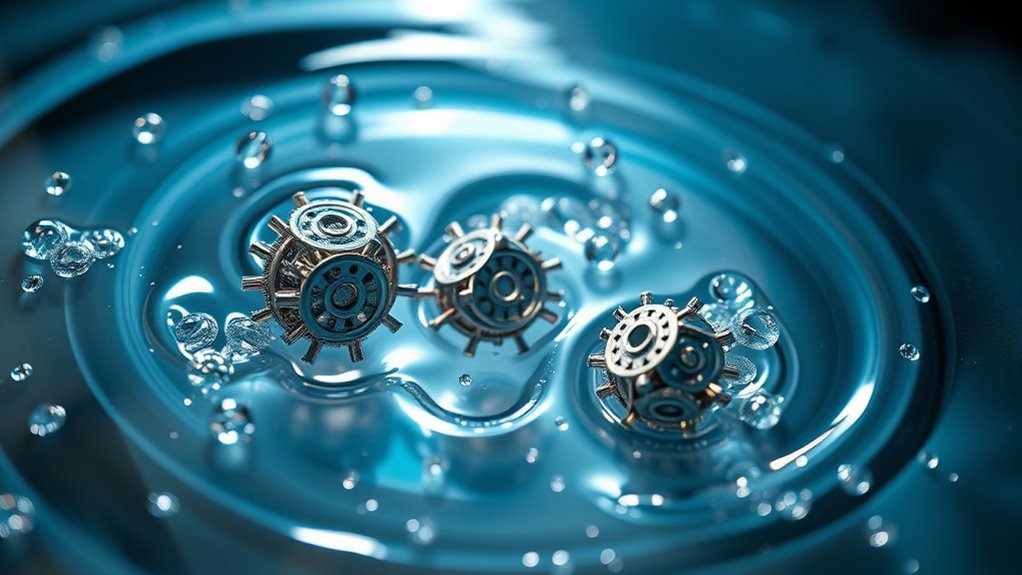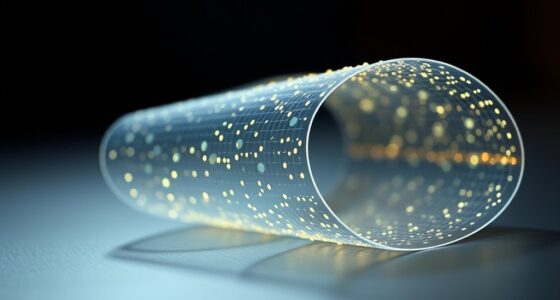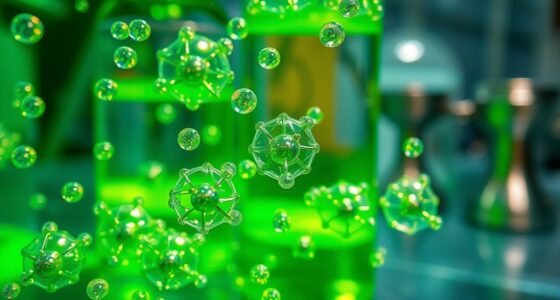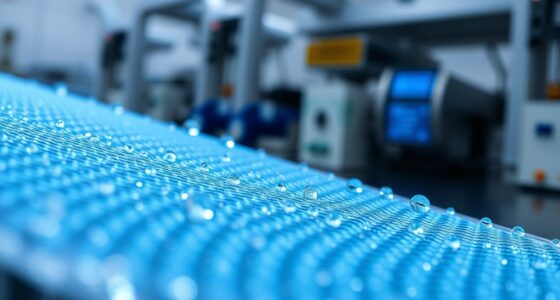Nanomachines in wastewater treatment combine nano filtration and engineered microbes to remove pollutants more efficiently. Nano filtration acts as a first barrier, filtering out salts, heavy metals, and organics at a molecular level. Microbial nanobots then target and neutralize remaining toxins, degrading complex molecules into harmless substances. This dual approach reduces chemical use, cuts costs, and boosts sustainability. Keeping an eye on these advancements uncovers how they’re shaping cleaner, safer water systems for the future.
Key Takeaways
- Microbial nanobots can identify and neutralize specific pollutants in wastewater at the cellular level.
- Nanomachines enhance the degradation of complex organic compounds, improving water purification.
- They operate alongside nano filtration systems to target pollutants that pass through physical filters.
- Nanomachines can be customized to address emerging contaminants like microplastics and pharmaceuticals.
- Integrating nanomachines with filtration reduces chemical use and operational costs in wastewater treatment.
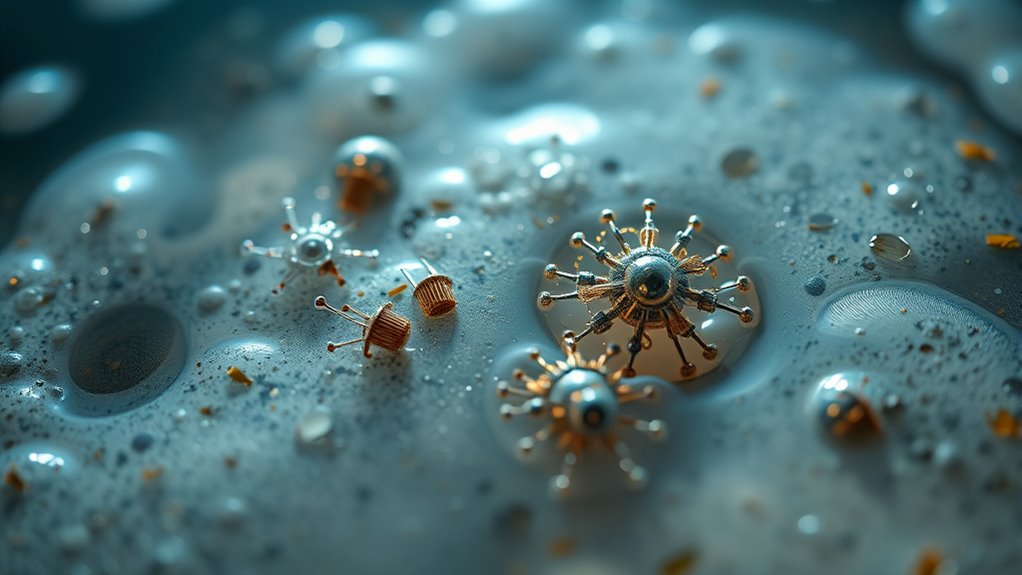
Nanomachines are revolutionizing wastewater treatment by offering precise and efficient ways to remove contaminants. Among these innovations, nano filtration stands out as a powerful technique that uses extremely fine membranes to filter out pollutants at a molecular level. Unlike traditional filtration methods, nano filtration can target specific contaminants, such as heavy metals, salts, and organic compounds, with remarkable accuracy. This process not only enhances water purification but also reduces energy consumption, making treatment more sustainable. When combined with microbial nanobots, the system becomes even more effective. Microbial nanobots are tiny, engineered organisms or machines designed to seek out and break down pollutants directly within the water. These nanobots can be programmed to identify specific toxins and neutralize them, providing a targeted approach to wastewater cleanup that wasn’t possible before.
As you explore the potential of these technologies, you’ll see how nano filtration acts as the first line of defense, physically removing a broad range of contaminants through ultra-thin membranes. The nanobots then step in to address residual pollutants that may slip through the filters. Because these microbial nanobots can operate at the cellular level, they can degrade complex organic molecules into harmless compounds, effectively cleaning the water from within. This dual approach maximizes removal efficiency and minimizes chemical usage, which is a significant advantage for environmentally conscious treatment plants.
Furthermore, the integration of nanotechnology allows you to design systems that are adaptable and scalable. You can deploy nano filtration modules alongside microbial nanobot treatments in various settings, from small-scale local facilities to large municipal plants. The precision of nano filtration means fewer chemicals are necessary for disinfection and purification, reducing the environmental footprint of the process. Meanwhile, microbial nanobots can be customized to target emerging contaminants, including pharmaceuticals and microplastics, ensuring your wastewater treatment keeps pace with new pollution challenges. Additionally, advancements in natural techniques like organic biopesticides and beneficial insects can complement nanotech solutions for comprehensive environmental management.
In practical terms, you’ll notice that these advancements lead to cleaner water output, lower operational costs, and improved safety standards. The combination of nano filtration and microbial nanobots transforms wastewater treatment into a more intelligent, responsive process. With ongoing research and development, you’ll see even more sophisticated nanomachines entering the scene, making wastewater treatment not just more effective but also more sustainable and adaptable to future needs. These innovations promise a cleaner environment and healthier water resources, thanks to the incredible potential of nanomachines working at microscopic scales.
Frequently Asked Questions
Are Nanomachines Safe for Long-Term Environmental Use?
Nanomachines can be safe for long-term environmental use if properly designed and tested. You should consider their environmental impact, ensuring they don’t harm ecosystems or cause bioaccumulation concerns. Responsible development involves thorough assessments to prevent unintended consequences. When managed correctly, nanomachines may offer effective, eco-friendly solutions without posing significant risks to the environment over time. However, ongoing research is essential to confirm their safety profile.
How Cost-Effective Are Nanomachines Compared to Traditional Methods?
You’ll find nanomachines are promising, with studies showing they can cut treatment costs by up to 50%. When comparing costs, the initial investment for nanotech may be higher, but the long-term savings and efficiency boost make it worthwhile. This cost comparison highlights their potential, and considering investment feasibility, nanomachines could become a cost-effective solution for wastewater treatment, especially as technology advances and scales up.
Can Nanomachines Be Customized for Specific Wastewater Contaminants?
Yes, nanomachines can be customized for specific wastewater contaminants through tailored nanomachines with contaminant-specific design. You can engineer these nanomachines to recognize and target particular pollutants, improving efficiency and selectivity. This customization allows for precise treatment, reducing the need for broad-spectrum methods. By focusing on the contaminant’s properties, you enhance removal rates, making wastewater treatment more effective and environmentally friendly.
What Are the Potential Risks of Nanomachine Deployment?
Like a double-edged sword, nanomachines carry risks you must consider. If they malfunction, you risk environmental bioaccumulation, where toxic materials build up in ecosystems, threatening health and biodiversity. You could also face unpredictable nanomachine behavior, leading to unintended consequences. To safeguard your environment, you need strict controls and thorough testing, ensuring these tiny tools don’t become hidden hazards in your wastewater management.
How Scalable Are Nanomachines for Large Wastewater Treatment Plants?
Scaling nanomachines for large wastewater treatment plants presents significant challenges. You’ll face scaling challenges that stem from manufacturing limitations, as producing vast quantities of precise, reliable nanomachines isn’t straightforward. While these machines can be effective on smaller scales, expanding their use demands advancements in manufacturing processes and cost reduction. Overcoming these obstacles is essential if you want nanomachines to be a practical solution for large-scale wastewater treatment.
Conclusion
You might be surprised how nanomachines could turn wastewater treatment upside down, just like how a tiny spark ignites a big change. As these microscopic marvels work behind the scenes, they could effortlessly clean water and uncover solutions we never saw coming. It’s almost like nature itself whispered, “Here’s the answer,” and now we’re just starting to listen. With nanomachines, the future of clean water feels closer than ever—proof that small things can make a huge difference.
